The next-gen MacBook Pro with Retina Display Review
by Anand Lal Shimpi on June 23, 2012 4:14 AM EST- Posted in
- Mac
- Apple
- MacBook Pro
- Laptops
- Notebooks
Last year when I wrote about the new MacBook Airs I offered two forward looking paragraphs:
What happens from here on out is what's really interesting. Intel has already committed to moving the TDP of its mainstream parts from 35W - 45W down to 10 - 20W. Since the Air is the new mainstream Mac notebook, Apple has already made that move. The performance in this 10 - 20W segment is going to get much better over the next two years, particularly once Haswell arrives.
The Thunderbolt Display is the first sign of what's to come. Moving IO controllers and expansion into the display, and potentially even moving discrete GPUs out of the notebook are all in store for us. Apple is really ahead of the curve here, but it's easy to imagine a future where laptops become a lot more like the new Air and shift to a couple high bandwidth ports instead of numerous lower bandwidth connections.
Perhaps I was being too aggressive in the prediction of a couple of high bandwidth ports. After all, the next-generation MacBook Pro with Retina Display features four such IO ports (2 x Thunderbolt and 2 x USB 3.0). But you get my point. Gigabit Ethernet and Firewire 800 are both gone. The discrete GPU is still present but I suspect even its days are numbered, at least inside the chassis. The personal computer as we knew it for so long, is changing.
The personal computer is getting thinner, lighter, more integrated and more appliance-like. The movement is no longer confined to just Apple either. The traditional PC OEMs are following suit. Even Microsoft has finally entered the PC hardware business, something it threatened to do for years but hadn't until now. Distribution models will change, the lines between different form factors will continue to blur. What was once a mature industry is going through a significant transformation. It’s exciting but at the same time it makes me uneasy. When I first got into this industry everyone had stories of companies with great ideas that just didn’t make it. As we go through this revolution in computing I’m beginning to see, first hand, the very same.
Apple makes the bulk of its revenue from devices that don’t look like traditional personal computers. For the past couple of years I’ve been worried that it would wake up and decide the traditional Mac is a burden, and it should instead be in the business of strictly selling consumer devices. With its announcements two weeks ago in San Francisco, I can happily say that my fears haven’t come true. At least not yet.
It’s been a while since Apple did a really exciting MacBook Pro launch. Much to my surprise, even the move to Sandy Bridge, the first quad-core in a MacBook Pro, was done without even whispers of a press conference. Apple threw up the new products on its online store, shipped inventory to its retail outlets, updated the website and called it a day. Every iPhone and iPad announcement however was accompanied with much fanfare. The MacBook Pro seemed almost forgotten.
With its WWDC unveil however Apple took something that it had resigned to unexciting, dare I say uncool status, and made a huge deal about it. Two weeks ago Apple did the expected and offered relatively modest upgrades to all of its portable Macs, all while introducing something bold.
Apple calls it the MacBook Pro with Retina Display. You’ll see me refer to it as the next-gen MacBook Pro, Retina MacBook Pro, rMBP or some other permutation of these words.
After using it for the past two weeks I can honestly say it’s the best Mac Apple has ever built. And there’s a lot more to it than hardware.
Portability
If you were hoping for a 15-inch MacBook Air, that’s not what the rMBP is. Instead it is a far more portable 15-inch MacBook Pro. I have to admit I was a bit let down the first time I laid eyes on the next-gen MacBook Pro, it looks good but it doesn’t look all that different. The disappointment quickly faded as I actually picked up the machine and started carrying it around. It’s not ultra light, but man does it make the previous chassis feel dated.
While I never really liked lugging around the old MBP (and it always made me feel like the old fogey at tradeshows where everyone else had something 13-inches or smaller), carrying the rMBP is a pleasure by comparison. Pictures really don’t do it justice. The impressively thin display assembly or overall chassis thickness look neat in a photo but it’s not until you actually live with the rMBP that you can appreciate what Apple has done here. I carry around a 15-inch MacBook Pro because it’s my desktop, and as such it’s incredibly useful to have with me when I travel. For my personal usage model, the Retina MacBook Pro is perfect.
If your workload demands that you need the performance of a MacBook Pro and your lifestyle requires you to carry it around a lot, the reduction in thickness and weight alone will be worth the upgrade to the rMBP. If you spend most of your time stationary however, you’ll have to be sold on the display and internal characteristics alone. The bad news is if the design doesn’t get you, everything else will.

From left to right: 11-inch MacBook Air, 13-inch MacBook Air, 15-inch MacBook Pro, MacBook Pro with Retina Display
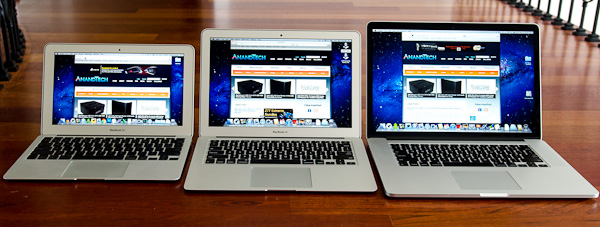
From left to right: 11-inch MacBook Air, 13-inch MacBook Air, MacBook Pro with Retina Display
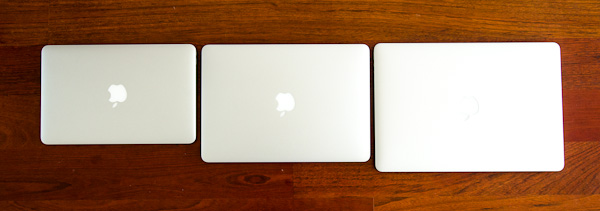
From left to right: 11-inch MacBook Air, 13-inch MacBook Air, MacBook Pro with Retina Display



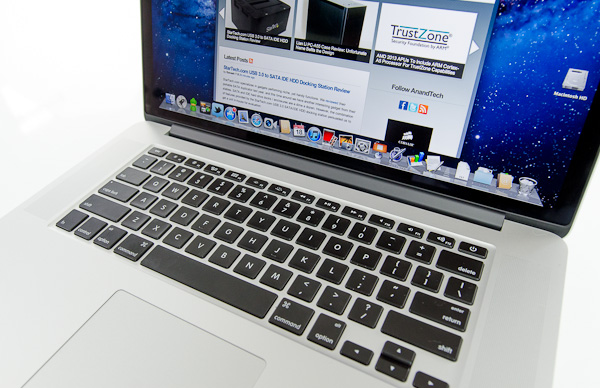
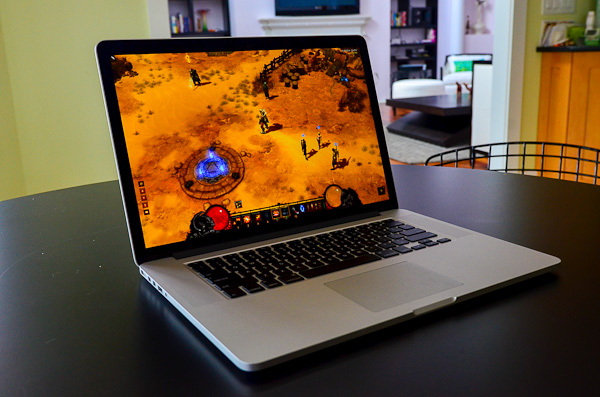
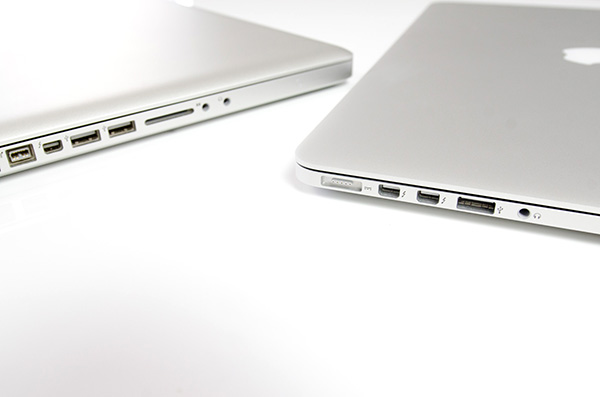
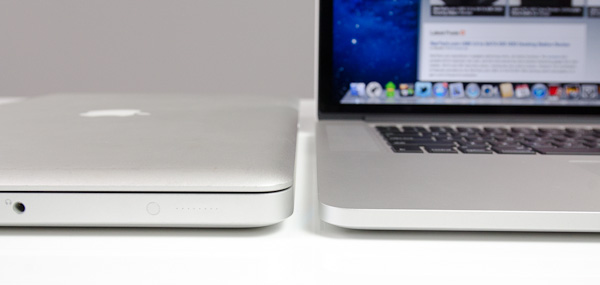








471 Comments
View All Comments
wendoman - Saturday, June 23, 2012 - link
Coming soon as usual.I've been using QuickSync fast encoding for free for over a year.
Spoony - Saturday, June 23, 2012 - link
That's really great for you. Fast encoding with QuickSync is nice. I've used it too, and wished it would get OS X support. Happy to see that is is now.Side note, all of the Windows-based encoders that execute QuickSync use an application-internal package. OS X will be implementing this at the system level, all software today that asks for an encode from QTKit should get it handed off to the fixed-function encoder. It's a much nicer solution, in my opinion.
AnotherNetNarcissist - Saturday, June 23, 2012 - link
Well done. Your medal is in the post.Taft12 - Monday, June 25, 2012 - link
That makes you and Anand who seem to care. We're up to two! I've yet to meet anyone else that does.iCrunch - Saturday, June 23, 2012 - link
...for an amazingly detailed review! This is what I had been waiting for, but nobody else comes even close to the technical knowledge and its applications.I have the "entry-level" rMBP (2.3GHz/8GB/256GB "SSD" NAND Flash) and the first thing I did was to remove Lion and install Mountain Lion DP4 with its thus far single major update. No UI elements ever flashed on me and everything seems to render just right in Safari 6 as well as throughout ML's UI elements and text. That's in both the "Ideal" Retina mode as well as WSXGA+ (1680x1050) and WUXGA (1920x1200). In the latter two modi, everything is just smaller, as you'd expect, but I find that under ML and Safari, it looks (virtually) as good as in "Retina" mode (1440x900).
Have you found any evidence of WUXGA icons in native resolution, for example, as a possible explanation as to why it scales so unbelievably well? I was truly hoping for a second native resolution for SXGA+, which would have entailed an even higher (3360x2100) native resolution, but as I'm typing this in WUXGA, in the highest of the 5 resolution modes, I find everything to appear as though it were native resolution. The crispness of text and images/icons throughout OS X 10.8 ML as well as the absurdly fast Safari 6, or is it all scaling, almost disproving the rule that any display's native (=highest) resolution works best?
As for the SSD, co-incidentally, I had two 180GB Intel 520 Series SSD's in my now former Late-2011 antiglare 17" MBP. I was happy to read through tons and tons of benchmarks spread throughout various articles right here on Anandtech, and even happier to find out that the Samsung 830 Flash that's in my Retina MBP (the 256GB version) and the Intel 520 (180GB) that I had before seemed to be highly comparable in virtually all categories. I am thinking about getting the 2.6 version with the 512GB Flash, but as seems to be the case with the 480GB Intel 520 Series, the 1/2 TB SSD's seem to be a tad slower than those in the 240/256GB range. Any ideas as to why?
IKeelU - Saturday, June 23, 2012 - link
I believe calling this a "revolution in computing" is hyperbole. I/O is evolving, as it always has. Computer density is increasing, as it always has. If anything, the new Mac Pro demonstrates that much improvement can be had in the device itself. It's not just a matter of improving connectivity to more capable devices.DeciusStrabo - Saturday, June 23, 2012 - link
I agree, but in the last few years we saw a backslide in screen resolutions on mobile devices. We had 1920x1200, IPS years ago. Suddenly we got 1366x768, TN, glare on the large majority of laptops. So the change to larger resolutions again (not only Apple, others too have started to include 1080p screens with their laptops as mainstream option).But generally you're correct. We moved from 1024x768 on 15-17" screens everywhere to 27" 2560x1440 IPS being available for as low as 600 USD. Over the next 2-3 years 4k displays will become mainstream for TVs. Technology is moving on, Apple is just one to seize if first here.
solipsism - Saturday, June 23, 2012 - link
Why is 1080p being compared to this display? Even the display in the iPad being powered by a mobile iGPU far exceeds that of 1080p.DeciusStrabo - Saturday, June 23, 2012 - link
Because it is the mainstream option available to laptops outside of one single one (and some old ones like the T61)?dagamer34 - Sunday, June 24, 2012 - link
The iPad doesn't have to deal with a window layering system which greatly reduces the amount of overdraw it has to deal with.